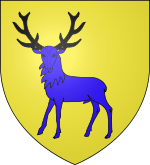Strachan baronets
Background
In 1619 James I erected the Baronetage of Ireland and laid plans for a further new Baronetage with the object of assisting the colonisation of Nova Scotia. However, in 1624 he died before this could be implemented. In 1625 Charles I took up the previous plans and erected the Baronetage of Scotland and Nova Scotia. The new baronets were each required to pay 2000 marks or to support six settlers for two years.
When Charles I erected the Baronetage of Scotland and Nova Scotia in 1625 there was a reluctance amongst suitable persons to purchase the honour, probably because 2000 marks was considered to be extortionate. In order to popularise the new Baronetage Charles I gave its members the right to wear the badge of Nova Scotia around the neck suspended by an orange tawny ribbon. It consists of a silver shield with an azure saltire imposed upon it together with an inescutcheon of the Arms of Scotland. There is an Imperial Crown above the inescutcheon and the motto Fax mentis Honestae Gloria encircles the whole badge.
(Ref. http://www.baronetage.org)
Strachan baronets, of Thornton, Kincardine (1625)
King James VI of Scotland [also I of England] was succeeded by his son, King Charles I in 1625. Like his father before him, King Charles I (1600–1649) seems to have been greatly taken with the then Baron of Thornton, Sir Alexander Strachan. In 1625, the year of his accessions to the thrones of England and Scotland, Alexander Strachan of Thornton acquired the Baronet of Nova Scotia. In the following year King Charles made him a member of the Commission of Grievances, a member of the Commission of the Exchequer, and a member of the Privy Council.
Contrary to what many believe, the Strachan of Thornton arms were not established by this time, as the Act establishing the Court of the Lord Lyon were not enacted until 1672. Prior to 1672, Arms or more appropriately seals would have been seen on charters, grants, and other legal documents... without colours. And, would have been designed and differenced largely by the user himself.
This said, William Strachan, Counsellor-at-Law, London [who was NOT of the Inchuthill cadet line] was issued Arms and Supporters by the Court of the Lord Lyon
- His blazon reads, "Azure, a stag trippant Or, attired and unglued Gules. Crest – An arm and hand holding a scimitar bendways Proper. Supporters – Two foresters clothed vert, with capes Sable, a belt round their waists and staves in their hands proper. Motto- Forward."
These Arms give a priority claim to the chiefship in favour of William (1756).
According to the Book, Bonnet Lairds, authored by Collin Thornton-Kemsley of Thornton Castle.
c 1601–1638 Sir Alexander Strachan of Thornton (born 1587) became the 1st Baronet of Thornton (c 1625).
c 1648–1658 Lieut. Col. Alexander Strachan of Thornton – 2nd Baronet of Thornton
c 1657–1658 The Baronetcy, estate and castle of Thornton passed to Sir James Strachan, 3rd Baronet of Thornton and Minister of Keith.
Strachan baronets, of Inchtuthill (1685)

According to the book Bonnet Lairds, page 83:
The third Baronet of Thornton was in fact Sir James Strachan, son of James Strachan of Inchtuthill in the parish of Delvine in Perthshire, an "opulent Burgess of Edinburgh", who died on 6 January 1651.
The Inchtuthill Strachans (a cadet branch of the Strachans of Thornton) had established themselves in the county of their adoption and "Master James Strachan of Inchtuthill" was appointed to the Committee for War in that county in 1648. The Parliament of 1650 received a report in his favour.
Sir James’ predecessor and distant cousin, Colonel Alexander Strachan, 2nd Baronet, was heavily indebted to David Strachan. Sir James Strachan of Inchtuthill, 3rd Baronet, took it upon himself to pay the debt in order to secure for himself, his wife, and children the Thornton estates to where they planned to move (1659). Therefore, the Baronetcy of Thornton and its estate was succeeded by an extremely remote relative, James Strachan of Inchtuthill.
As mentioned above, Sir James’ eldest son (also named James) died during the Jacobite uprising in 1689, leaving his second son, John, to become of 4th Baronet of Thornton. Much of the balance of this chapter has been contributed by Ben Strachan in his book, "A History of the Strachans."
John would be succeeded by his son, Sir William Strachan, 5th Baronet.
At this point, the family line started a decline as Sir William Strachan died without heir, and the barony passed to his brother, Sir Francis Strachan (Bart. 1725) who was a Jesuit Priest in Paris.
Sir Francis died, leaving his cousin, Sir John Strachan (Bart. 1753) 7th Baronet.
John, like the two before him, died without heir, and the Barony passed to his nephew Captain Sir John Strachan RN – 8th Baronet of Thornton.
Sir John married Elizabeth, daughter of Robert Lovelace of Battersea, but had no male heir. The baronetcy passed to his nephew, Sir Richard John Strachan at the age of 17.
Later baronets
In the eighteenth century, the title was claimed by Captain Sir John Strachan (died 1777) and his nephew Sir Richard Strachan (died 1828), styled "fifth" and "sixth" baronets. This claim was disputed by Sir Robert Strachan (died 1828), styled "eighth baronet", based on a Scottish inquest of 1777.
In 1841, a third branch of the family were served heirs in another inquest, but this claim has been in abeyance since 1854.
See also
References
- Burke, John; Burke, Sir Bernard (1844). A Genealogical and Heraldic History of the Extinct and Dormant Baronetcies of England, Ireland and Scotland (2 ed.). J. R. Smith. p. 367.